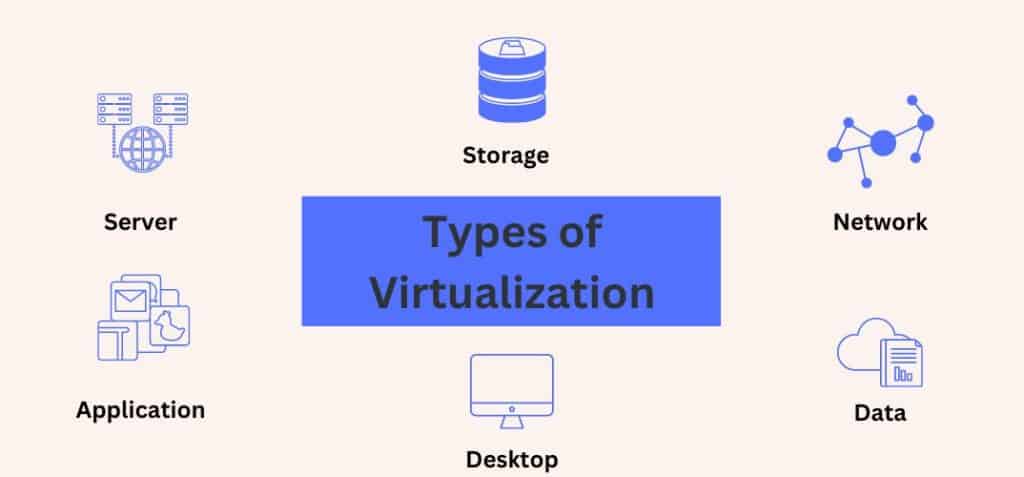If you own a website with medium-level traffic but don’t need resources dedicated solely to your website, then VPS hosting is your best choice. It will provide virtual resources to help you scale your website according to your needs. All this with minimum cost and maximum flexibility!
Besides, if your website is rapidly growing and in need of more resources, then you can easily migrate to a dedicated server with the right web hosting provider.
Let’s say you have decided to go for VPS hosting. The next step is to choose the best server virtualization technology suitable for your website’s server.
Here we will look at KVM and OpenVZ VPSs, two of the most popular virtualization technologies.
What is Virtualization?
"Virtualization is a technology that combines or divides computing resources to present one or many operating environments using methodologies like hardware and software partitioning or aggregation, partial or complete machine simulation, emulation, timesharing, and many others." - Chiueh, S. N. T, and Brook, S., A Survey on Virtualization Technologies. RPE Report, pp. 1-42, 2005.
Virtualization provides an isolated environment for the application of the operating system. As the users want maximum utilization of the hardware resources, virtualization technique offers the opportunity to obtain optimum benefits similar to real machines.
To make it simple, let’s use an analogy. VPS hosting is like working in a cubicle instead of taking up the whole cabin. And virtualization is like the design used to divide the workspace into different cubicles.
Types of virtualization

- Server Virtualization: Server virtualization refers to partitioning the resources of a server and distributing them over a network.
- Storage Virtualization: Storage virtualization works by merging multiple physical storage arrays and presenting them as a single storage location to the user over a network.
- Network Virtualization: Network virtualization refers to combining all the components of networks and administering them using only software.
- Application Virtualization: Application virtualization refers to deploying a computer application over a network (the cloud). It takes away the drawbacks of installing applications locally.
- Desktop Virtualization: In this, powerful servers host several desktop sessions concurrently and deploy desktop environments over a network.
- Data Virtualization: Data virtualization enables organizations to manage and alter data from several sources.
Among all these types of virtualization, our focus is on server virtualization. It allows flexible scalability and enables users to request various configurations of storage, computing power, and RAM from the physical server.
What Exactly is Server Virtualization?
Are you planning on running multiple applications that require different OS requirements? There is no better way than virtualization for you.
Server virtualization helps to maximize the power of any device. By implementing the proper services and software, a single piece of hardware can match the duties of multiple machines. It can also help protect servers by masking resources from independent users.
Let’s have an understanding of various types of server virtualization;
- Full Virtualization: Full virtualization lets you create isolated virtual machines (VMs). The main components of this setup are the host (the physical hardware resource), the guests (the VMs), and the hypervisor (a virtual machine monitor to run the VM). The hypervisor communicates with servers to manage disk space and monitor CPU usage.
- Para-Virtualization: Paravirtualization is a type of virtualization where software instructions from the guest operating system running inside a virtual machine can communicate directly with the hypervisor. It provides an interface similar to software running natively on the host hardware.
- OS-Level Virtualization: Containerization or OS-level virtualization means configuring the system’s kernel to create user spaces (usually called containers) that can run independently. Containers have separate file systems and processes, but in addition to the allocated hardware resources, they also utilize the host’s kernel. Therefore, it means that users can’t run an operating system different from the one on the physical server.
Different virtualization solutions have distinct strengths and weaknesses. For example, full virtualization supports both Linux and Windows virtual machines. However, the performance is relatively poor. Para-virtualization can’t support Windows OS virtual machines, but its performance is much better.
How Does a Hypervisor Works?
Hypervisor is a layer between the OS and hardware that enables virtualization.
In full virtualization, the hypervisor merges resources inside the system; this results in guest operating systems (VMs) competing for resources. Whereas in para-virtualization, the hypervisor enables collaboration between guest operating systems.
OS-level virtualization or containerization uses kernel for splitting OS into partitions called containers.
What is Virtualization in Web Hosting?
Virtualization technology offers affordable solutions to common issues in shared web hosting plans.
With the help of cloud computing, virtualization ensures your website is accessible even when your machine is down. It also helps in account isolation, even when using the same server as other websites.
If you are a VPS client, you will get a virtual server with guaranteed hardware resources and a dedicated IP. As a result, you needn’t worry about other users putting too much load on the server or posing a security risk to their project.
Several virtualization solutions using different virtualization approaches and technologies are available. KVM and VMware use full virtualization to provide a complete virtual environment for several guest OSs. Xen can use para-virtualization to provide an API for guest domains. Solutions such as OpenVZ and Linux Containers provide ways to partition OS in logically isolated containers.
Let’s try to understand KVM and OpenVZ, two of the most popular virtualization technologies. They are both free too!
What is KVM?
KVM (Kernel-Based Virtual Machine) is an open-source virtualization technology. It has been a part of the Linux kernel since 2007 and is a full-virtualization module that lets you turn Linux into a hypervisor. It helps the host run multiple isolated virtual machines.
What is Kernel? The kernel is a computer program at the core of a computer's operating system and generally controls everything in the OS. It is a part of the operating system code that is resident in memory and facilitates interactions between hardware and software components.
The KVM is a part of Linux code, so it automatically benefits from all the new features, fixes, and advancements of Linux.
Let’s check out the features of KVM, which make it an enterprise’s preferred hypervisor.
- Enhanced security and isolation
- Improved storage and provides redundancy
- Utilize a wide variety of certified Linux-supported hardware platforms
- Reliable memory management for better performance
- Supports live migration
- Fair scheduling and resource control
- Better prioritization make sure apps are running accordingly
- CPU Hotplug support – Adding CPUs on the fly
- KVM Paravirtual Clock – A paravirtual time source for KVM
- PCI Hotplug support – Adding PCI devices on the fly
- VM channel-Communication channel between the host and guests
- Nested Guests – Running virtual machines within virtual machines
What is OpenVZ?
OpenVZ is an OS-level virtualization technology in Linux. It is a free and open-source virtualization solution like KVM. This technology is also called containerization; isolated containers use the host’s kernel and act as independent machines with their files, processes, IP addresses, libraries, etc.
Have a look at some of the features of OpenVZ;
- Easy setup, configuration, and management
- Effective utilization of resources
- Simplified implementation process
- Low overhead prices and easy maintenance
- Isolated traffic and firewalling for individual containers
Let’s Compare

The right level of virtualization is often a concern for customers considering a VPS. It is imperative to consider what virtualization your web host can offer once you’ve measured RAM and disc space requirements.
As mentioned above, KVM and OpenVZ are the most popular virtualization technologies. Both have advantages, but looking at lists of features is not enough to tell you which one will best suit you. To find out, you need to pit them head-to-head. Let’s do that!
1. Hardware Requirements
Hardware requirements are different for both KVM and OpenVZ.
Hardware-level virtualization with KVM requires a hypervisor, which is the server itself. Running a hypervisor requires computing power, so guest machines can’t share all system resources. It is necessary to reserve some of them for the hypervisor.
With OpenVZ’s OS-level virtualization, you don’t need a full-fledged hypervisor, and all its containers run with minimal overhead on the host. Containers can safely distribute as much as 99% of the hardware of a physical server.
2. OS Support
OpenVZ can only host Linux operating systems, while KVM is more flexible and can host Linux, Windows, and custom OS options.
Most hosting companies use Linux for their physical servers, and if they use KVM virtualization, there would be no problems setting up a Windows or a FreeBSD VPS as well.
OpenVZ is a Linux distribution; all containers use its kernel. As a result, running the containers on anything other than Linux is not an option.
3. Kernel Version
KVM has better customizability. It allows complete isolation for the virtual machines from the rest of the server. Admins can make as many modifications to the individual VMs’ kernel as they prefer. Using a different kernel or customizing an existing one does not affect other virtual machines or servers.
OpenVZ’s OS-level virtualization requires using the host’s kernel, meaning any modifications are out of the question.
4. Memory Distribution
With KVM, you have hard limits on the memory for each VM, whereas OpenVZ’s unused memory is available to every container running on the server. This particular characteristic of OpenVZ’s setup makes overselling much easier.
The memory allocation won’t be a problem if there aren’t too many containers on the server. Still, if the RAM usage on one of the VPS machines shoots up, it could negatively affect the performance of all other accounts.
Overselling is a terrible practice some hosting companies employ in an attempt to maximize profits. It involves overcrowding a server with too many users and exceeding the underlying hardware’s capacity. The result is poor performance and downtimes. Keep this in mind if you decide to get OpenVZ VPS.
5. Price
KVM and OpenVZ are open-source and completely free to use. You can even download and enable them on your home Linux computer.
KVM is the more expensive option because of its higher hardware requirements and complicated setup. The lower overhead and the easy configuration make OpenVZ a favorite among companies preferring budget solutions.
Which Virtualization is the Best Option For You?
Most website owners won’t be able to tell the difference between an OpenVZ and a KVM. Still, it is significant for the quality of the hosting service you will receive. Thus it’s a crucial decision when choosing your VPS hosting provider.
Firstly, the hardware-level virtualization in KVM allows the hosting provider to offer self-managed Windows VPS machines alongside Linux-based solutions. It means more flexibility and the ability to meet the hosting needs of a wider audience with different needs.
Secondly, the extra isolation makes KVM virtualization much more reliable and secure. It provides fully managed VPS solutions with daily backups, robust security, and an easy-to-use control panel. For bigger businesses, gaming purposes, and other uses that demand a dedicated server, KVM is the right option.
Finally, If you are just starting with VPS Hosting, with its lower overhead cost, easy setup, and maintenance, OpenVZ is the best choice.
